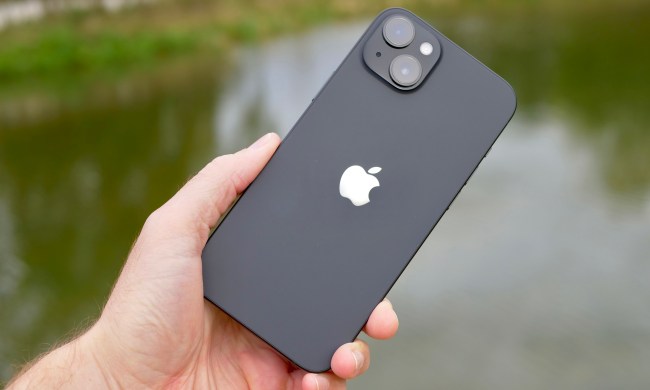
These days, it seems that smartphones are just getting bigger and bigger each year, with all manufacturers trying to one-up each other in terms of who has the biggest screen. But not everyone wants an enormous phone, because some of us value having something compact enough that can easily fit into pockets and want a phone that can be used with one hand only. Believe it or not, there are options out there if you want something small.
While many people want to "go big or go home," there are still some of us out here who prefer something smaller. Of course, we aren't talking about going back to the original iPhone size, but just having a small and compact phone that doesn't have a gigantic footprint is nice, you know? And remember what it's like to use a phone with one hand easily? Those were the days!
Thankfully, there are still a few phones that offer great experiences in smaller bodies. Without further ado, here are the best small phones you can buy in 2023!






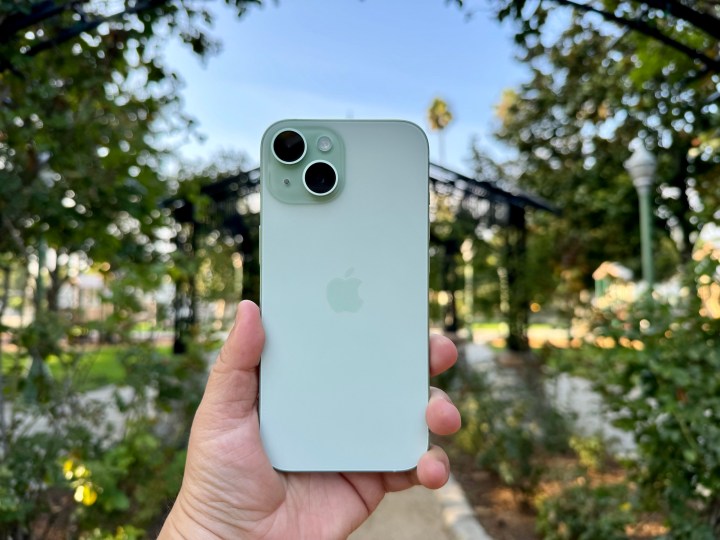
The best small iPhone
iPhone 15
- Big camera upgrade
- USB-C
- Matte glass feels incredible
- Dynamic Island
- Curved edges are more comfortable
- Reverse wired charging
- 60Hz refresh rate display
- Most color options are too light
- Can get warm when running intensive apps
- Won't get Apple Intelligence in iOS 18
Why you should buy this: If you want the latest and greatest from Apple in the most compact form factor, you can’t go wrong with the iPhone 15.
Who it’s for: Those who want an iPhone that’s small, lightweight, and powerful.
Why we picked the iPhone 15:
Apple made some big improvements to the standard base model iPhone 15 this year, making it one of the best small iPhones you can buy right now — especially if you want the latest and greatest.
Though the iPhone 15 body looks similar to its predecessor, Apple did make a few changes this year. First, the back is made with a new color-infused glass, which has a matte finish that is superior over the glossy backs from before. Fingerprints don’t show up as much and it is nicer to hold. It also has more rounded curves on the edges, so it’s not as sharp as the iPhone 14 and much more comfortable to grip.
The iPhone 15 now also has the Dynamic Island, which was previously introduced on the iPhone 14 Pro series, eliminating the notch. And the 6.1-inch display looks great with color and text, offering bright and vibrant color and sharp and crisp text. It reaches 1,000 nits of regular brightness and 2,000 nits for peak outdoor brightness. However, it still only has a 60Hz refresh rate, but for the most part, scrolling and animations aren’t too bad on it.
Apple made some big improvements to the iPhone 15 camera. The main camera is now 48MP and photos will default to 24MP resolution (for more detail) and Smart HDR 5 improves the overall color tone. The ultrawide and selfie camera are still 12MP, which is a little disappointing, but the photos that you get still look quite good. The iPhone 15 also has support for the new Auto Portrait feature, so you can turn any photo into a portrait after the fact (as long as it focused on a person or pet).
You have the A16 Bionic chip in the iPhone 15 and 6GB RAM. It may not be as powerful as the Pro models, but it still runs iOS 17 smoothly and without any issues. For most people, it should still exceed expectations. Battery life will last at least a full day before you need to put it on the charger. Speaking of, it also uses USB-C now instead of Lightning, though Apple didn’t increase the charging speeds.
The iPhone 15 is small, powerful, and very lightweight thanks to the aluminum frame. If you want a small iPhone, this is the one to get.

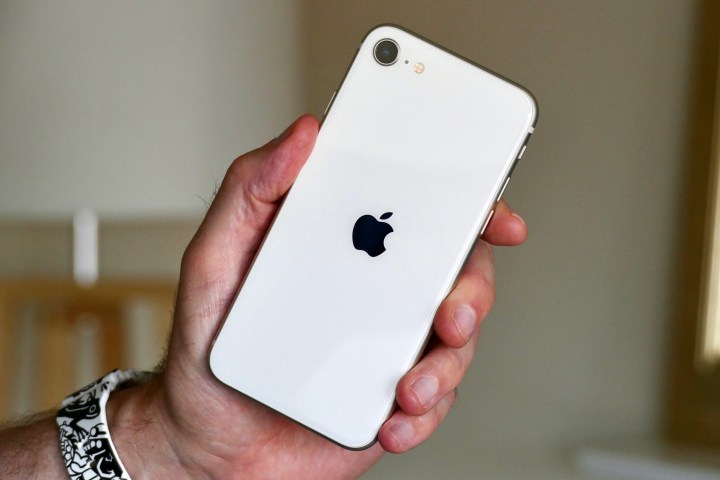
The best small iPhone runner-up
Apple iPhone SE (2022)
- Compact and light
- Very powerful
- Touch ID works really well
- Wireless charging
- IP67 water resistance
- Poor battery life
- 60Hz screen
- 64GB won't be enough
Why you should buy this: If you want an affordable, small iPhone and don’t mind some compromises, the iPhone SE is a great value.
Who’s it for: Those who want a small iPhone that is affordable and even still has a Home button.
Why we picked the iPhone SE (2022):
If you want a small iPhone that is the most affordable and don’t mind making some compromises, then the iPhone SE can be a good fit.
With the iPhone SE, you’re getting the iPhone 8 body with the insides of the iPhone 13 series, so it’s an interesting little mashup of sorts. This means you still have a Home button and a dated appearance, but the more modern internals with the the A15 Bionic chip.
The 4.7-inch display is tiny compared to the larger screens on the flagship iPhones these days. But it does have a modest 326ppi, which isn’t too shabby. Colors are nice and bright and text is easy to read. However, it only has a 60Hz refresh rate, which is getting dated at this point in time.
The single lens 12MP camera is an odd one when you look at it now compared to the competition, even more new iPhones. Still, Apple makes this basic camera quite impressive, as you can actually use it to take portrait mode photos of people, which is not too bad. But you won’t have night mode, the selfie camera is only 7MP, and you can only record up to 1080p.
Battery life isn’t that that impressive though, as you’ll definitely need to charge up after a full day. And keep in mind that the iPhone SE only has up to 64GB of storage, which really isn’t much. But if you just want a basic iPhone for simple things, then this should be okay.

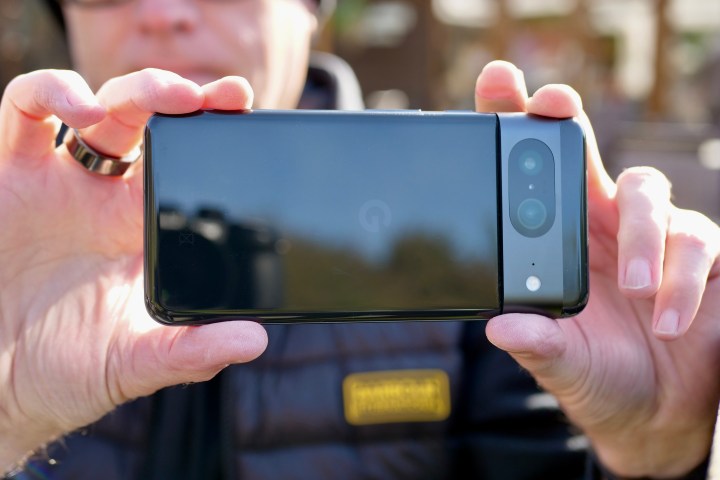
The best small Android phone
Google Pixel 8
- Great main camera
- Amazing AI photo editing tools
- Two-day battery life
- Slick, fast Android 14
- Tensor G3 is cool and efficient
- Seven years software support
- Wide-angle camera disappoints
- Average charge speed
Why you should buy this: A small and compact Android phone with some powerful AI features that deliver great results for smartphone photography.
Who’s it for: Anyone who wants a small phone and prefers Android over iOS.
Why we picked the Google Pixel 8:
This year, Google actually reduced the size of the Pixel 8 by 0.1-inches in the screen. While this may seem like a negligible change, it helps make the Pixel 8 feel much more compact than previous iterations. And when you combine the 6.2-inch display size with the matte aluminum frame and polished glass, it becomes a very lightweight phone that's simple to use.
Speaking of the display, the Pixel 8 has a new OLED “Actua Display” panel that has 2400 x 1080 pixel resolution, 2,000 nit peak brightness, and has a variable refresh rate between 60Hz and 120Hz.
The Pixel 8 is powered by Google’s own Tensor G3 chip and 8GB RAM, which seems to have improved over previous iterations that would get hot when under stress. While the G3 chip can get warm, it never gets hot, at least to the point where it’s uncomfortable to hold the phone. The Pixel 8 comes with Android 14 installed and Google promises seven years' worth of software updates.
One of the reasons to use a Pixel is for the excellent camera system, and you get that on the Pixel 8 as well. You have a 50MP main camera, 12MP ultrawide, and 10.5MP selfie camera. There is no telephoto lens on the Pixel 8 — you need the Pixel 8 Pro for that. Regardless, photos that you take on the Pixel 8 will look great, with vibrant colors that still look natural. Plus, with all of the AI photo editing tools that you have at your disposal such as Best Take and Magic Editor, you can get some great results that are worthy enough to share on social media or with family and friends.
You also get pretty good battery life with the Pixel 8, as it will last more than a day with the 4,575mAh battery capacity. Plugging in for 30 minutes gets about 50% charge, and you also have 18W Qi-charging and reverse wireless capabilities.

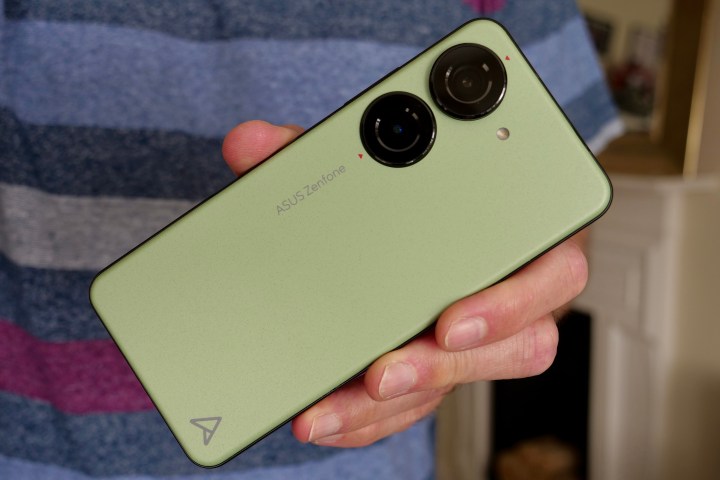
The best small Android phone runner-up
Asus Zenfone 10
- Compact size is welcome
- Great performance
- Clean, simple software
- Slow charging speed
- Gimbal doesn't reach its potential
Why you should buy this: This phone is tiny but it’s packed to the brim with power and performance.
Who’s it for: Anyone who wants a smartphone that you can easily use one-handed.
Why we picked the Asus Zenfone 10:
The Asus Zenfone 10 is one of the smallest Android phones you can buy right now. It is less than 70mm wide and 150mm tall, making this phone perfect for one-handed use.
Asus gave the Zenfone 10 a simple yet unique appearance. The rear features two large camera modules and the Asus logo in the corner feels very futuristic. You also get a tactile material for the rear, which provides more grip and is fingerprint-resistant. It even has a headphone jack, though the chassis itself is quite thick at 9.4mm. Still, this is a very compact phone compared to other options.
The Asus Zenfone 10 has a compact 5.92-inch AMOLED display with a maximum refresh rate of 144Hz for certain games and 120Hz for typical use. You have Qualcomm’s Snapdragon 8 Gen 2 chip inside, along with 16GB RAM, so this is quite a powerhouse in a tiny package. The display can also reach 1,100 nits peak brightness, so while it’s not as bright as other phones, it is still plenty usable in sunlight.
The cameras on the Asus Zenfone 10 are decent, though it won’t be better than a Pixel or iPhone. The 4,300mAh battery cell will get you through a full day at least, and it takes about 30 minutes to get a 50% charge plugged in. This is also the first time that Asus has added 15W wireless charging to a Zenfone.
If you value one-handed use above all else, including camera performance, then the Asus Zenfone 10 is perfect for your needs.

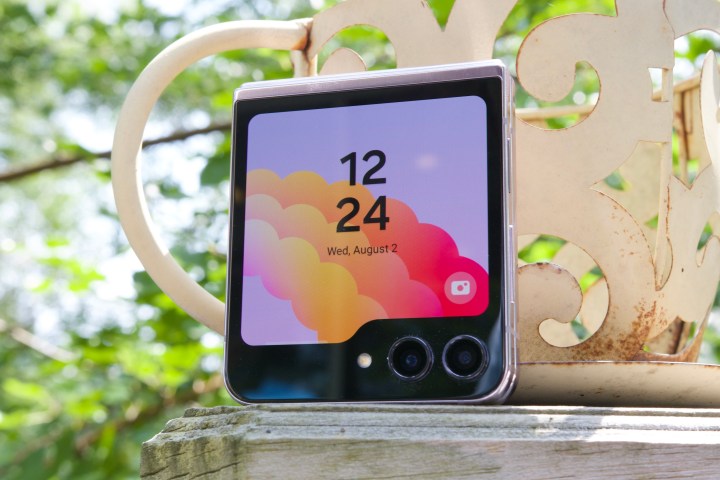
The best small folding phone
Samsung Galaxy Z Flip 5
- No more gap when folded shut
- Extremely well-built
- Hinge feels outstanding
- Much more useful cover screen
- Fantastic performance
- Good and dependable cameras
- 5 years of updates
- The crease is still there
- Mediocre battery life
- Cover screen requires lots of tweaking
Why you should buy this: It packs in power and performance in a super compact flip format.
Who’s it for: Those who want the smallest and most compact form possible for their smartphone.
Why we picked the Samsung Galaxy Z Flip 5:
For several years now, Samsung has been the reigning champ when it comes to foldable phones, and that still holds true with the Galaxy Z Flip 5.
Since the Galaxy Z Flip 5 is a folding flip phone, it is the absolute smallest form factor that you can get if you want a small phone. Samsung also made improvements with the Z Flip 5 with the new Flex Hinge, which allows it to fold completely flat with no unsightly gaps, and this also makes the phone even thinner when closed compared to its predecessor.
Other improvements include the larger cover display, which is a 3.4-inch Super AMOLED panel with 720 x 748 pixel resolution and 60Hz refresh rate. You can also run any apps on the cover display, though there’s a bit of setup to do before it’s running properly. The cover display has several different widget panels that are useful, too.
The inner display is also very lovely. It’s identical to last year’s 6.7-inch Dynamic AMOLED 2X display with 2640 x 1080 resolution, and has a refresh rate up to 120Hz. The brightness level also now reaches 1,750 nits, making it very usable in bright sunlight. The crease is pretty prominent, though it does not affect day-to-day use.
The cameras on the Galaxy Z Flip 5 are the same as last year but with some noticeable improvements. Thanks to the Snapdragon 8 Gen 2 chip, the Z Flip 5 has an upgraded image signal processor that gives better color translation in photos and video. And when combined with the 8GB RAM, the Snapdragon 8 Gen 2 can handle pretty much anything you throw at it.
Just don’t expect incredible battery life since this is a small flip phone. The 3,700mAh battery cell in the Galaxy Z Flip 5 should get you through the day, but it will definitely need a charge at night. It has 25W wired charging speed, 15W wireless charging, and also has 4.5W reverse wireless charging.


The best small Samsung phone
Samsung Galaxy S23
- Sleek and compact design
- Comfortable for one-handed use
- Very fast performance
- Reliable cameras take great photos
- Long-lasting battery life
- Five years of guaranteed updates
- Base storage is still 128GB
- Fast charging up to only 25W
- Limited zoom quality past 10x
Why you should buy this: The smallest of the S23 family still packs in power, performance, and reliability.
Who’s it for: Those who prefer Samsung and still want a traditional slab phone.
Why we picked the Samsung Galaxy S23:
Though the Galaxy S23 is the smallest of the S23 lineup (including the S23 Plus and S23 Ultra), it’s still a great Android phone, especially for those who prefer the smaller form factor.
The Samsung Galaxy S23 is a perfect size for those who like small phones. It has a 6.1-inch screen and only weighs 5.93 ounces. It’s also easy to use one-handed due to being so lightweight, so if that’s what you are looking for, then the Galaxy S23 is a great choice.
On the Galaxy S23, you get a 6.1-inch Dynamic AMOLED 2X display that looks bright and vibrant. It has 2340 x 1080 resolution with an impressive 425ppi, so everything looks crystal clear and sharp. The brightness can reach 1,750 nits, so it’s also plenty usable in sunlight.
The cameras on the Galaxy S23 are also impressive, as it comes with a triple lens camera system despite being the base model. With a 50MP main, 12MP ultrawide, and 10MP telephoto, you can get great shots no matter what situation you’re in.
You also have the Snapdragon 8 Gen 2 for Galaxy in the S23 with 8GB RAM. That means the S23 is plenty fast when you need it, and the chip also helps with power efficiency. The S23 can go over a day on a single charge with the 3,900mAh cell, and it has 25W charging speeds, 15W wireless charging, and 4.5W reverse wireless.

Frequently Asked Questions
Smartphones started growing larger when user preferences turned to all content all the time, especially in the form of reading, watching video, and playing games. These activities benefit from increased screen real estate. The problem is that larger phones are heavier, harder to carry and use with one hand, and more expensive. Large phones are inconvenient for people with small hands or with those who do not have 100% use of both hands. If you prefer to stash your phone in a shirt or pants pocket, want to or must use your phone with one hand, do not mind watching videos on a slightly smaller screen, and appreciate a more compact, lightweight unit, a small phone may be the optimal choice for you.
The immediate impact of a small smartphone is the size of the screen, but secondary attributes like smaller batteries, less powerful processors, inferior cameras, and less storage space will likely factor into how small you want to go. Notice we said nothing about the price. While large phones are more expensive, choosing a small phone may not save you significant money, and the price may even be on par with some of the larger models. That's because a high-quality small smartphone cleverly packs high-end features into a small package, and you are still paying for that high quality. Thus our favorite iPhone mini or SE or the Google Pixel are great choices for a small size phone that do not skimp on features or materials.
Smartphone sizes are a matter of personal style and necessity. If you appreciate having a phablet that fits into your backpack or purse for cinematic video, conference calls, report reading, art creation, gaming, or any other work or entertainment-related activities that are better suited to a spacious canvas, then stick with a larger smartphone. If you are a traveler who is not toting around a full laptop array of tech gear, a large phone will serve many purposes exceptionally well. You'll benefit not only from a large bright screen, but likely a larger, long-lasting battery, and even extra RAM built in.



